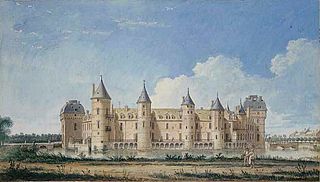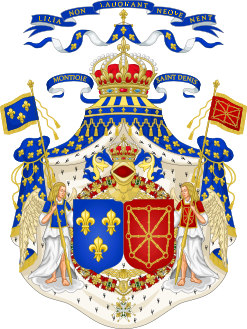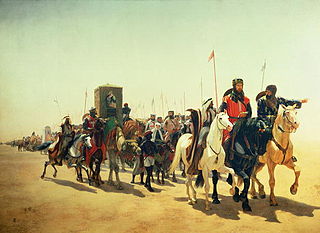
Blazon: D'or, à deux fasces de sable, accompagné de neuf merlettes du même (3, 3 et 3)
Guillaume de Ferrières, Vidame de Chartres (c.1150 – ?April 1204) was a French nobleman, probably the same person as the trouvère whose works are recorded only as by the Vidame de Chartres, his title. Eight songs in total have been attributed to the Vidame, though all but one with conflicting attributions to others. He is not to be confused with Raoul de Ferrières (fl. 1200–10), also a trouvère.

Vidame de Chartres was a title in the French nobility. There are a few vidame titles in France, of which that of Chartres is probably the best known, because a number of holders have been notable in widely different ways over the centuries. Vidame was originally the name for the commander of a bishop's military force in the Early Middle Ages, when bishops, like other great lords, needed troops for security. The title eventually developed into a heritable noble title, like others linked to a specific estate. The title therefore passed to the new owner when the estate was sold, as happened a number of times in this case.

The French nobility was a privileged social class in France during the Middle Ages and the Early Modern period to the revolution in 1790. The nobility was revived in 1805 with limited rights as a titled elite class from the First Empire to the fall of the July Monarchy in 1848, when all privileges were abolished for good. Hereditary titles, without privileges, continued to be granted until the Second Empire fell in 1870. They survive among their descendants as a social convention and as part of the legal name of the corresponding individuals.
Trouvère, sometimes spelled trouveur[tʁuvœʁ], is the Northern French form of the langue d'oc (Occitan) word trobador. It refers to poet-composers who were roughly contemporary with and influenced by the troubadours but who composed their works in the northern dialects of France. The first known trouvère was Chrétien de Troyes and the trouvères continued to flourish until about 1300. Some 2130 trouvère poems have survived; of these, at least two-thirds have melodies.
Guillaume took part in the Third (1188–92) and Fourth Crusades (1201–4), and died in Romania as part of the latter. A reference in the Vidame's song Combien que j'aie demouré to a forced sojourn in a "hated land" probably refers to Guillaume's stay in southwestern France in 1188, before the departure of the Crusade, while the leaders (Richard the Lionheart and Philip Augustus) were squabbling. Further evidence linking the trouvère with Guillaume includes a quotation of two stanzas of the Vidame's most popular song, Quant la saison du dous tens s'asseure, in the chivalric romance Guillaume de Dole , which was written probably in the 1220s. Quant la saison was, by implication, written some years prior. The rather garbled and uncertain melodies which accompany the Vidame's poems further support an early (pre-1200) date for the trouvère. One piece of evidence relating to the identity of the Vidame has not yet been adequately explained. The coat of arms with which the trouvère is depicted in his miniature portrait in the Chansonnier du Roi belonged mid-century to the Meslay family, who became vidames of Chartres only in 1224.

The Third Crusade (1189–1192) was an attempt by the leaders of the three most powerful states of Western Christianity to reconquer the Holy Land following the capture of Jerusalem by the Ayyubid sultan, Saladin, in 1187. It was largely successful, recapturing the important cities of Acre and Jaffa, and reversing most of Saladin's conquests, but it failed to recapture Jerusalem, which was the major aim of the Crusade and its religious focus.

The Fourth Crusade (1202–1204) was a Latin Christian armed expedition called by Pope Innocent III. The stated intent of the expedition was to recapture the Muslim-controlled city of Jerusalem, by first conquering the powerful Egyptian Ayyubid Sultanate, the strongest Muslim state of the time. However, a sequence of economic and political events culminated in the Crusader army sacking the city of Constantinople, the capital of the Greek Christian-controlled Byzantine Empire.

The Empire of Romania, more commonly known in historiography as the Latin Empire or Latin Empire of Constantinople, and known to the Byzantines as the Frankokratia or the Latin Occupation, was a feudal Crusader state founded by the leaders of the Fourth Crusade on lands captured from the Eastern Roman (Byzantine) Empire. It was established after the capture of Constantinople in 1204 and lasted until 1261. The Latin Empire was intended to supplant the Byzantine Empire as the titular Roman Empire in the east, with a Western Roman Catholic emperor enthroned in place of the Eastern Orthodox Roman emperors.
Only one of the eight songs variously attributed to the Vidame is not also ascribed to another. Only three, however, are regularly doubted to be his, and only one of these—Quant foillissent li boscage—is almost certainly not his. One of the remaining two, Desconsilliez plus que nus hom qui soit, which survives without music, is attributed in one manuscript to Li viscuens de Chartres (the viscount of Chartres), probably an error for vidame.
A viscount or viscountess is a title used in certain European countries for a noble of varying status. In many countries a viscount, and its historical equivalents, was a non-hereditary, administrative or judicial position, and did not develop into an hereditary title until much later. In the case of French viscounts, it is customary to leave the title untranslated as vicomte[vi.kɔ̃t] and vicomtesse.
Five of the Vidame's songs are basically isometric and decasyllabic. The remaining three are heterometric but mainly octosyllabic. With the sole exception of Li plus desconfortés du mont, all his melodies are preserved in bar form and cover more than an octave in range each. Though most survive with modal structures, these vary from manuscript to manuscript and are unreliable.
Bar form is a musical form of the pattern AAB.
In music, an octave or perfect octave is the interval between one musical pitch and another with double its frequency. The octave relationship is a natural phenomenon that has been referred to as the "basic miracle of music", the use of which is "common in most musical systems". The interval between the first and second harmonics of the harmonic series is an octave.
